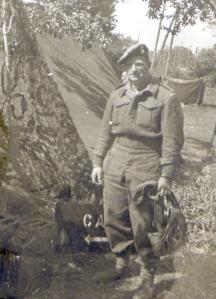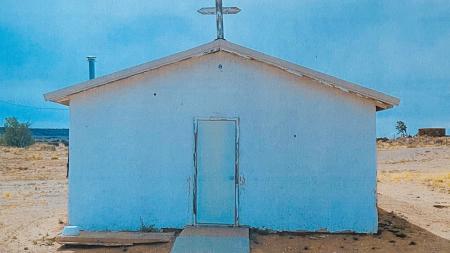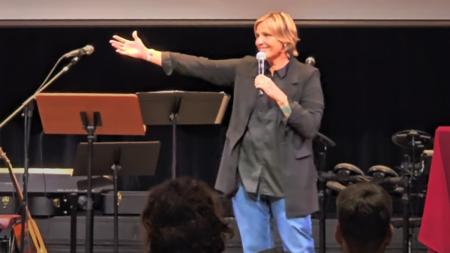Remembering D-Day: Sam Black

To mark the 75th anniversary of the D-Day invasion, when Allied troops landed in Normandy, France, on June 6, 1944, CRC News published a story last week on George St. Cyr, a member of Heritage Christian Reformed Church in Brampton, Ont., who was among the soldiers who landed in Normandy. This week, CRC News includes the accounts of two other soldiers who made the landing 75 years ago this Thursday.
When World War II began in 1939, Sam Black, an art teacher in Scotland, enlisted in the Royal Scottish Fusiliers and, eventually, after being called up, received a commission in the Officer Corps. Before he landed at Normandy, among other things, he was asked to come up with a drawing for the cover of the top-secret plans for Operation Overlord, the name of the Allied invasion. Black received several medals and commendations for his heroism while in military service. Offered here are excerpts of his writings, provided by Myra Davey, his daughter, a member of Victoria (B.C.) Christian Reformed Church.
Being a secondary school teacher at the outbreak of war, I was in a “reserved occupation,” and, although I had volunteered, I was obliged to wait until I was called to the services.
Before the year was out, I was called up to the army and was sent to the Royal Scots at Glencorse Barracks, south of Edinburgh, beginning life in the army as a private. I became a corporal and was selected to go forward to officer training. . . . After some initial training in Ayr, I was sent to Sheringham in Norfolk, England, where I commanded a group of Fusiliers, guarding the East Anglian coast in anticipation of a Nazi invasion. While there I was asked to be a camouflage officer at Farnham in Surrey. After a course in various aspects of camouflage, I became a staff-lieutenant of camouflage and was sent to Norwich to work with Captain Oliver Messel. At first, our job was mainly concealment of defences and training men. . . . However, as the war situation changed and we had less need to expect invasion, we also changed to prepare to move into attack and in return to liberate Europe.
A Camouflage School was created, and I was appointed its First Commandant with the rank of Captain. My job was to help officers and men to know the basics of concealment and behaviour and to begin to understand how to use different ground patterns to their advantage.
For example, we confounded the German Luftwaffe by creating illusions of material and bombing destruction on and around UK bases. Among other things we painted bomb craters on runways of airfields to make it appear from the air that the runways were unusable for any landings or take-offs.
After some months, I was made Camouflage Officer to Force 125. This was a special force of Airborne Troops, Commandos, etc., whose specific job was to intercept the Nazis should they try to invade and capture Morocco in an effort to cause the Americans trouble in North Africa. This did not happen, so our special force became the planning group for the invasion of Europe in June of 1944 and was designated 1st British Corps. I then became Capt. S. Black, Camouflage Officer, and 1st British Spearhead Corps.
I will tell you about an interesting side-light at a time of serious importance.
Prior to embarkation (to Normandy), Brigadier Balfour came to me and asked me to design the cover for the final plan for the landings that was to be sent to General Montgomery. Brigadier Balfour said that the poor soldiers would be weighed down by tons of paper and to try and depict that.
My drawing for the 1st Corps OVERLORD plan shows a soldier, being prodded up the beach by Captain Neptune, overloaded with papers – Top secret, Most secret, Urgent, etc, etc. He has the 1st Corps Spearhead insignia on his arm, and the four corners show the arm insignia of the four divisions involved. The Brigadier liked the cover and sent it off to [General] Montgomery and Co. I wonder if Montgomery ever noticed it [before it was used], and if so, did he crack a smile?
I was timetabled to land on Juno Beach on the afternoon of D-Day, but because of the storm and some slight hitches did not get ashore till the morning of D-Day+1.
I had a small unit comprising a Staff-Lieut., a Sergeant, and a Driver-Batman Private. . . . [My] job was helping units in concealment; men, vehicles, guns, etc.
As the war proceeded, greater and greater deception was used in conjunction with concealment. Deception and Concealment Units combined to produce bluff and double bluff, with for us good results, especially when lives were saved.
My rank throughout remained a Captain known as G.S.O.3 [General Staff Officer 3], and I remained a Royal Scots Fusilier. Towards the end of hostilities I was promoted to become a G.S.O.2, a Major.
In a newspaper article published in the London [Ont.] Free Press in 1971, Black, by then a college art professor, wrote about returning and strolling the beach at Normandy, the same place where he had landed during the D-Day invasion:
Twenty-seven years ago, I, in company with many others, had arrived from the sea on the biggest seaborne invasion in history.
Dwelling in the past is a sure sign of old age, but talking and thinking about it can surely be forgiven when so much that affected the world and mankind’s future hinged on the outcome of those battles on the beaches of June 6, 1944.
It would be callous if I could not remember with a mixture of pride and sadness, those brave young men who burst from their landing craft, on that grey and stormy June dawn, to assault the seemingly impregnable front line defences of Nazi Fortress Europe. In the sector I speak of, British and Canadians smashed gaps in that bristling, armored crust and gained a foothold for freedom on Norman soil. Many never saw the goal achieved but gave their lives that it might happen.
I visited the beach where, among the Canadians, I had disembarked. The picture, burned in my mind of that beach 27 years before, had completely changed.
The little track up over the sand dunes past the shattered Nazi gun emplacements was still there. The big concrete mass lurched at a drunken angle — the result of the double action of the battle bombardment and the shifting sands of time — and raised its incongruous bulk to the sky, its gun slits peering dark and sightless now, and no longer menacing.
Sunbathers relaxed in glistening oily bliss on the warm sand, and children, heedless of the great events that had occurred there, were busy building sandcastles.
I stood a moment, thinking and lost in dreaming of the past, but the detached prattle of the playing children broke my mood and brought me back to the present.
I left the beach, this time unopposed, and journeyed on into the beautiful Normandy countryside — close, high-hedged bocage country with steep-banked [hills and] . . . plain, old, solid stone villages, each with its simple uncluttered grey Norman church. A comfortable fertile, land-lover’s land, going about its business with a pace measured, geared to, and governed by the seasons.
The scars of war are long since plowed under, gaping walls and broken buildings are restored or renewed, and the torn and discarded metal garbage of war has disappeared. There remain, sprinkled here and there, a few concrete defenses, block-houses — stark reminders of those wasteful and destructive times.
Perhaps, after all, the best memorial to the men who sacrificed their lives is this peaceful continuance of normal life, and the children playing in innocent freedom on those once bloodstained beaches. . . .


